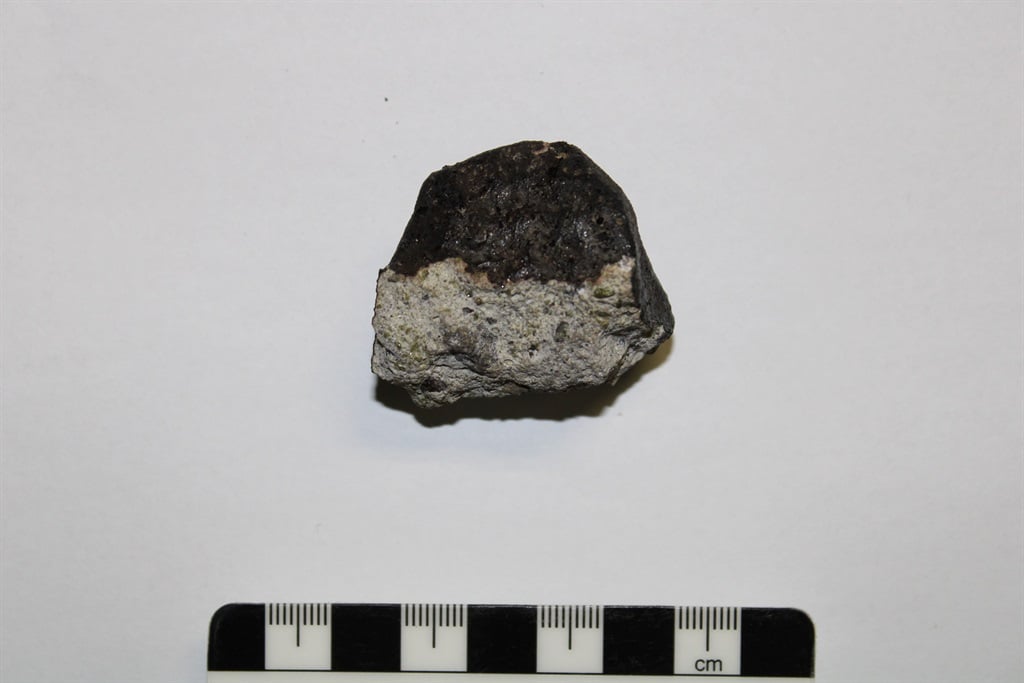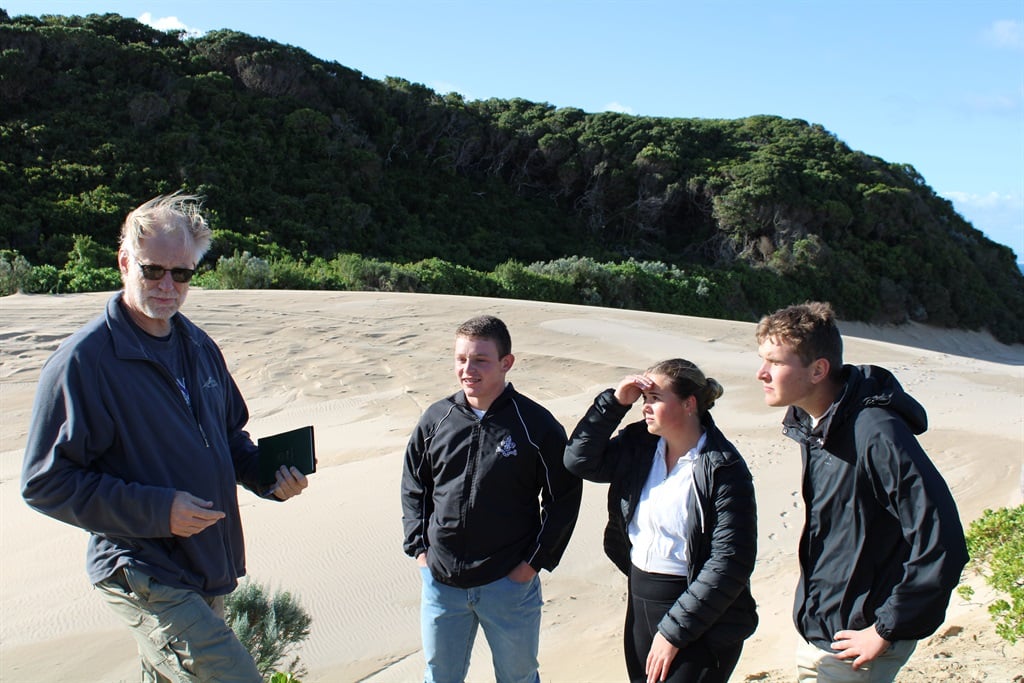
The main mass of the Nqweba meteorite. The sample is one of five that were collected. This sample weighs less than 63g and is less than 4cm in diameter. (Wits University/Supplied).
- The meteorite that roared through the Eastern Cape skies on 25 August travelled at 20.1 kilometres per second.
- When it exploded, energy equal to 92 tonnes of dynamite being detonated was released.
- Citizen scientists played a key role in helping scientists understand the event.
- For climate change news and analysis, go to News24 Climate Future.
The meteorite that roared through Eastern Cape skies last month was travelling at 72 360 kilometres per hour when it exploded north of Gqeberha, releasing energy equal to 92 tonnes of dynamite being detonated.
A consortium of scientists from the University of Witwatersrand, Nelson Mandela University, and Rhodes University hosted a media briefing on Tuesday to demystify the events of 25 August in the Eastern Cape, after many residents saw streaks of light through the sky and reported hearing a window-shaking, thunderous noise.
While the scientists drew data from many sources, it is two pieces of citizen science that have made the incident of the “Nqweba meteorite” so interesting.
Zoë van der Merwe captured a video of the incident while walking with her friends near St Francis Bay. While the video only lasted a few seconds, Van der Merwe managed to capture streaks of light from the meteorite on the tail end of its journey through the Earth’s atmosphere.
Adding to this record, nine-year-old Eli-zé du Toit found five fragments of the meteorite after it landed in Nqweba, north of Gqeberha.
Professor Roger Gibson from the Wits School of Geosciences said that while it is estimated that 10 to 15 meteorites hit Earth daily, many of these fall into the sea, and many are not spotted or recorded.
To understand the Nqweba meteorite, scientists used the video and fragments together with a report from a subsidiary of the National Aeronautics and Space Administration (NASA), which tracks meteorites, and data from a Cold War-era missile-detection facility near Kimberley.
Here is what the scientists have determined about the incident so far:
- The meteorite that entered into the Earth’s atmosphere was roughly 1m3 in size. Initial reports from Wits indicated that the meteorite was roughly car-sized, but this was revised downwards.
- Starting at 08:51, residents from regions spanning the Garden Route to the Karoo reported seeing a bright blue-white and orange streak of light in the sky.
- Data from NASA’s Center for Near-Earth Object Studies indicated that the meteor travelled at a cosmic velocity of 20.1 kilometres per second, equal to 72 360km/h. The meteorite slowed down as it entered the thicker parts of Earth’s atmosphere nearer the surface.
- The meteorite exploded at around 38km above the Earth’s surface. The explosion released energy equivalent to 92 tonnes of dynamite being detonated and resulted in a massive noise.
- The furthest report the scientists received of someone observing the incident was from Ceres, over 600km away from where fragments were spotted.
- The meteorite eventually landed in Nqweba, north of Gqeberha. Initial reports indicated that the meteorite may have landed in the water near St Francis Bay; however, scientists said they don’t have evidence for this. The meteorite split into five fragments on impact.
- The biggest fragment is 4cm long. Collectively, the remnants weigh about 90g.
- Dr Deon van Niekerk, a geologist and the head of the electron microscopy unit at Rhodes University, said that initial observations suggest that the meteorite is a howardite–eucrite–diogenite (HED). This category of meteorite only accounts for around 8% of the meteorites that humans have observed. HEDs were formed in the early solar system and this particular sample was likely formed 5 million years after the formation of the solar system.
Scientists confirmed that the meteorite was not space junk, such as a satellite that had been destroyed, and that the thundering noise that was detected was not an earthquake hitting the area.
He said useful data had been gathered from a facility in Boshof, near Kimberley, which is one of 60 devices from the Cold War-era dotted around the globe designed to pick up signals of high-speed objects in the upper area of the atmosphere, in case of a missile launch.
The infra-sound facility, which can detect sounds that the human ear can’t, registered a significant disruption at 09:22. Gibson said that this is in line with an explosion near Gqeberha at 08:53, as it would have taken 29 minutes for the sound to reach the receiver.
Scientific goals
Gibson said that while it is not uncommon for material from space to come down to Earth, only 75 000 specimens have been collected to study to date. This is enough to fill around two double-decker buses with meteorites. That said, between 100 and 200 tonnes of material enter Earth’s upper atmosphere daily, Gibson explained, most of which is sand or pea-sized and burns up upon entering the atmosphere, or comes down to the surface very slowly.
“The atmosphere is actually a very effective shield against small fragments,” Gibson said.
It takes a bigger meteorite to create the sort of phenomenon that the Nqweba meteorite created.
Gibson explained:
Bigger rocks have more momentum. Think of [Springbok rugby player] Eben Etzebeth running into you. You are not going to stop him. They [bigger rocks] are the lock forwards of the meteor world.
Van Niekerk said scientists would look to see if there were perhaps more landing sites for material, but it would be difficult to locate.
“It is incredible that someone was actually at the location where these rocks fell. There might be more rocks out there that we are going to look for, but it really is a needle in a haystack. There isn’t a lot of this material that reaches us. It is an incredible contribution to science,” said Van Niekerk.
Dr Leo Vonopartis, from the geoscience department at the University of the Witwatersrand, said that the scientists will now be performing a much more granular assessment of the meteorite to solidify initial observations and gain insight into the exact chemical nature of the rocks.
The scientists want to call the object the Nqweba meteorite after the region of the Eastern Cape where it fell. The name will need to be accepted by a council of the Meteoritical Society, which will review the findings of the scientists and decide whether to accept the incident into official meteorite records.
This article was originally published by a www.news24.com . Read the Original article here. .



